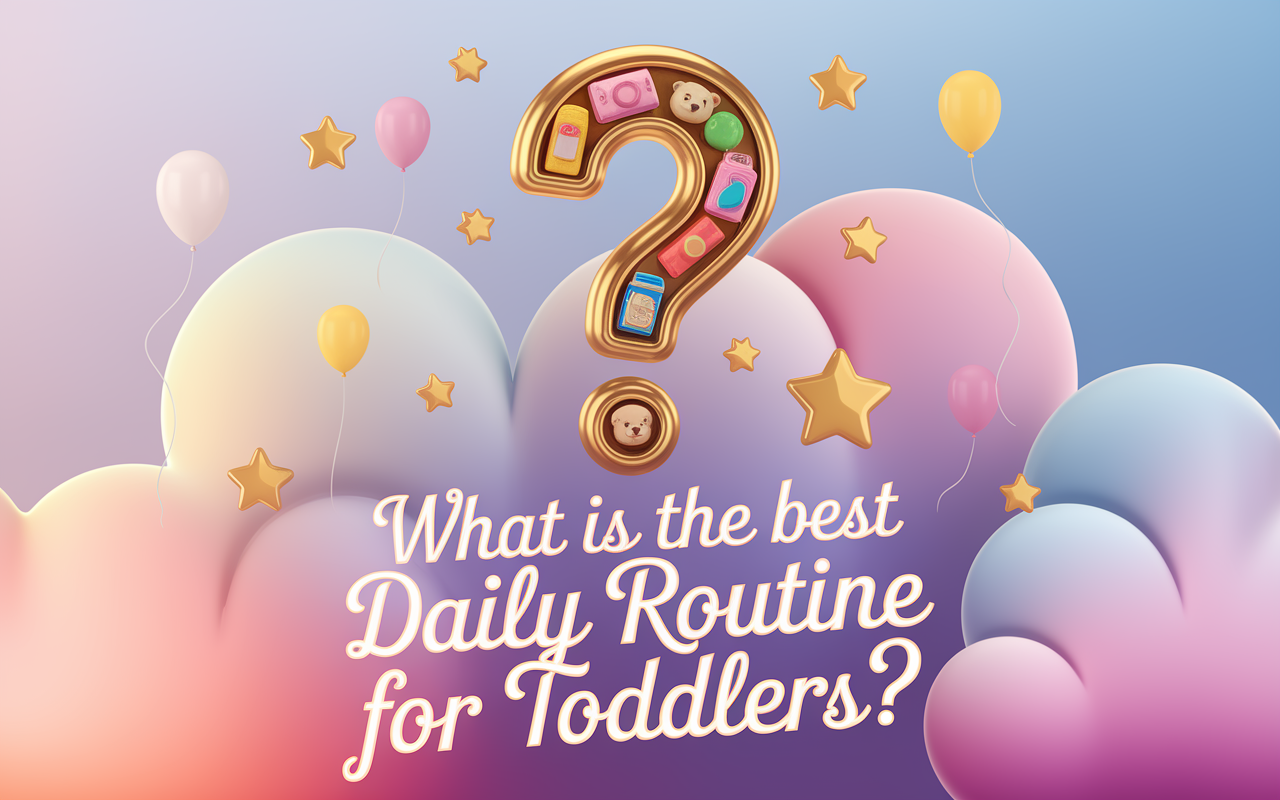Navigating the world of a toddler is a whirlwind of boundless energy, burgeoning independence, and big emotions. One moment they’re a whirlwind of joyful chaos, the next they’re melting down over the “wrong” color cup. For parents and caregivers, finding a sense of predictability amidst this beautiful storm can feel like an impossible task. The secret weapon? A consistent, yet flexible, daily routine. More than just a schedule, a well-crafted routine is a powerful tool that provides the structure toddlers crave to feel safe, the predictability they need to learn, and the rhythm that helps the entire family thrive.
This comprehensive guide will walk you through everything you need to know about creating the “best” daily routine for your toddler. We’ll explore the profound benefits, provide a detailed sample schedule you can adapt, offer age-specific modifications, and equip you with a toolkit of activities and troubleshooting tips. Let’s transform chaos into calm and create a daily rhythm that nurtures your child’s growth and your own well-being.
Why Routines Are a Toddler’s Best Friend
Before diving into the “how,” it’s crucial to understand the “why.” A daily routine isn’t about rigid timekeeping or creating a mini-adult. It’s about providing a predictable framework that acts as an invisible security blanket for your child. Their world is vast and often confusing; a routine helps them understand what comes next, reducing anxiety and freeing up mental energy for the important work of childhood: playing, learning, and growing.
Fosters Security & Trust
When a toddler knows that snack time follows play time, and nap time follows lunch, their world feels safe and predictable. This consistency builds a deep sense of trust in their caregivers and environment, reducing power struggles and anxiety.
Boosts Cognitive Development
Routines help toddlers understand concepts like sequence, time, and cause-and-effect. This foundational knowledge supports memory development, problem-solving skills, and prepares them for more structured learning later on.
Promotes Emotional Regulation
Knowing what to expect helps toddlers manage their big emotions. Fewer surprises mean fewer meltdowns. A predictable wind-down routine before naps and bedtime is especially critical for teaching them how to transition from high energy to a state of calm.
Encourages Independence
As toddlers learn the routine, they begin to anticipate the next step and participate actively. They might go get their shoes before a walk or bring you a book at story time. This builds confidence and a sense of “I can do it myself!”
Regulates Biological Rhythms
Consistent meal, nap, and bedtimes help regulate a toddler’s internal clock (circadian rhythm). This leads to better sleep, more stable energy levels, and even improved appetite, as their bodies learn when to expect food and rest.
Reduces Parental Stress
A routine isn’t just for the toddler! It brings predictability and structure to the parent’s day, reducing decision fatigue (“What should we do now?”). It carves out time for chores, work, and even rest, leading to a more present and patient parent.
The Golden Rule: Structure with Flexibility
The phrase “best routine” can be misleading. There is no one-size-fits-all schedule that works for every family. The true “best” routine is one that is built on a foundation of predictable rhythms but has enough flexibility to accommodate life’s inevitable curveballs: a sick day, a spontaneous park trip, or simply a toddler who isn’t quite ready for their nap.
Think “Rhythm,” Not “Rigid Schedule”
Focus on the sequence of events rather than the exact time on the clock. For example, the rhythm is “we wake up, we have breakfast, then we play.” Whether breakfast is at 7:15 AM or 7:45 AM is less important than the predictable flow. This approach allows for natural variations in your child’s needs while maintaining the security of the overall structure.
The goal is to create “anchor points” throughout the day—key events that happen in the same order around the same time each day. These anchors typically include meals, naps, and bedtime. The activities that fill the spaces in between can be more fluid and child-led. This balance is the key to a routine that serves, rather than constricts, your family.
A Blueprint for a Thriving Toddler’s Day
Here is a sample daily routine that incorporates key developmental activities. Use this as a template, a starting point to be molded to your child’s unique temperament, age, and your family’s lifestyle. Remember the golden rule: focus on the flow and the anchors, not the exact minute on the clock.
Rise & Shine 7:00 – 8:00 AM
The day begins with connection and gentle transitions. Avoid rushing. This morning connection sets the tone for the entire day.
- Gentle Wake-Up: Open curtains, sing a good morning song, and offer plenty of cuddles.
- Diaper Change & Potty: A fresh start. If potty training, this is a key time to offer the potty.
- Getting Dressed: Offer simple choices (“this shirt or that shirt?”) to foster independence. Talk about the weather and the day’s plans.
Breakfast Fuel-Up 8:00 – 8:30 AM
A nutritious breakfast powers the brain and body for a morning of play and learning. Involve your toddler in simple preparation tasks.
- Family Meal: Sit down together if possible. Model healthy eating habits.
- Toddler Helper: Let them help by carrying their non-breakable plate to the table or wiping up a small spill.
- Nutrition Focus: Aim for a mix of protein, healthy fats, and complex carbs (e.g., scrambled eggs with avocado and whole-wheat toast).
Active Play & Exploration 8:30 – 10:30 AM
This is prime time for high-energy, engaging activities that work on gross motor skills, creativity, and sensory exploration. This is the core “work” of a toddler.
- Outdoor Time: A trip to the park, a walk around the block, or even just backyard play is ideal.
- Gross Motor Skills: Building forts, dancing to music, playing with balls, or creating a simple obstacle course.
- Creative/Sensory Play: Set up a station for painting, play-doh, or a sensory bin with rice or water (with close supervision).
Quiet Time & Snack 10:30 – 11:30 AM
A crucial transition period to wind down from active play, refuel with a healthy snack, and engage in calmer activities before lunch and naptime.
- Healthy Snack: Offer fruit, cheese, or yogurt to tide them over until lunch.
- Fine Motor Activities: Puzzles, stacking blocks, threading large beads.
- Reading Together: Cuddle up on the couch with a few favorite books. This builds language skills and reinforces connection.
Lunchtime & Clean-Up 11:30 AM – 12:30 PM
Another anchor point in the day. Keep it low-pressure and focus on exposure to a variety of healthy foods.
- Variety is Key: Offer a small portion of a few different foods from different food groups.
- Dealing with Pickiness: Continue to offer foods without pressure. Include at least one “safe” food you know they’ll eat.
- Clean-Up Routine: Involve them in wiping their tray or putting their dishes in the sink. Singing a clean-up song makes it fun.
Naptime Routine & Rest 12:30 – 2:30 PM
A restorative nap is vital for a toddler’s mood and brain development. The pre-nap routine is just as important as the nap itself.
- Consistent Routine: Follow the same short sequence every day: e.g., potty, change into PJs, read one book, turn on white noise, say a sleepy phrase.
- Calm Environment: A dark, cool, and quiet room signals that it’s time for sleep.
- Quiet Time Alternative: For toddlers starting to drop their nap, enforce a “quiet time” in their room with books or quiet toys. The goal is rest, even if sleep doesn’t happen.
Post-Nap Snack & Gentle Play 2:30 – 3:30 PM
Toddlers often wake up groggy and hungry. Ease them back into the day with a snack and some low-key activities.
- Reconnect & Refuel: Offer cuddles and a nutritious snack as they wake up.
- Calm Activities: Simple art projects like coloring, listening to calm music, or looking at picture books.
- Independent Play: This can be a good time to encourage some independent play while you prepare for the afternoon’s activities or handle household tasks.
Afternoon Adventures 3:30 – 5:00 PM
This is a great window for errands, playdates, or another bout of outdoor time before the dinner and bedtime rush begins.
- Get Out of the House: A trip to the library, grocery store, or a playground can break up the day.
- Run Errands: Involve your toddler by giving them a “job,” like finding the bananas or putting items in the cart.
- At-Home Fun: If staying in, engage in some “practical life” work like “helping” with laundry (matching socks) or preparing dinner (washing vegetables).
Dinnertime & Family Connection 5:30 – 6:30 PM
Dinner is a key opportunity for family connection. Even a short time together at the table can make a huge difference.
- Conversation Starters: Ask simple, open-ended questions like, “What was your favorite part of today?”
- De-escalate Dinner Stress: Keep portions small and the atmosphere positive. Your job is to offer the food; their job is to decide how much to eat.
- Wind-Down Period: After dinner, engage in quiet play. Avoid high-energy activities or screens, which can interfere with bedtime.
Bedtime Wind-Down Ritual 6:30 – 7:30 PM
This is the most critical routine of the day. A predictable, calming sequence cues the body and mind that sleep is coming.
- The Classic “Bath, Book, Bed”: A warm bath can be very relaxing. Follow with PJs, brushing teeth, and reading a few stories in their dimly lit room.
- Connection is Key: Spend a few minutes cuddling, singing a lullaby, or talking quietly about the day.
- Consistency is Everything: Do the same things, in the same order, at the same time every single night. This is your most powerful sleep tool.
Customizing for Your Toddler’s Age
The “toddler” stage spans a period of massive developmental leaps. A 13-month-old’s needs are vastly different from a 3-year-old’s. Here’s how to adapt the routine for different stages.
- Sleep Needs: Still often on two naps per day. The morning nap might be around 9:30/10:00 AM, and the afternoon nap around 2:00/2:30 PM. Watch for sleepy cues.
- Play Style: Shorter attention spans. Play involves simple cause-and-effect toys, sensory exploration (touching different textures), and lots of movement as they master walking.
- Communication: Rely heavily on gestures, single words, and pointing. Narrate everything you do to build their vocabulary.
- Independence: Just beginning. They can help put toys in a basket or try using a spoon.
- Sleep Needs: Most transition to one, longer afternoon nap. This is a major routine shift that can take a few weeks to settle.
- Play Style: Beginning of pretend play (feeding a doll, talking on a toy phone). Attention span is growing. Can follow two-step instructions.
- Communication: Language explosion! They are learning new words daily and starting to string two words together.
- Independence: Strong desire for “me do it!” Offer lots of safe choices and simple tasks they can own, like choosing their snack or putting on their own shoes (with help).
- Sleep Needs: One solid afternoon nap. Some may start showing signs of dropping the nap closer to age 3. Replace it with mandatory “quiet time.”
- Play Style: More complex imaginative play, building intricate structures, and engaging in simple group games. Attention span is much longer.
- Communication: Speaking in full sentences, asking “why?” constantly, and can tell simple stories about their day.
- Independence: Potty training is often a major focus. They can handle more responsibility, like setting the table, helping with pets, or dressing themselves completely.
The Ultimate Activity Toolkit
Stuck on what to do during those play blocks? Keep a running list of ideas categorized by developmental area. This prevents decision fatigue and ensures you’re offering a well-rounded “diet” of play.
Navigating Common Routine Roadblocks
Even with the best-laid plans, you’ll hit bumps in the road. Toddlers are masters at testing boundaries. Here’s how to handle some common challenges with patience and consistency.
Nap Resistance
Your toddler suddenly refuses to nap. They play, sing, or cry in their crib for the entire nap period.
Solution: First, check the schedule. Are they ready to drop a nap or is bedtime too early/late? Second, protect the routine. Insist on “quiet time.” Frame it as “You don’t have to sleep, but you have to rest your body.” Keep the environment the same (dark and quiet). Often, after a few days of boundary-setting, they will resume napping. If not, you may have a new “quiet time” routine.
Picky Eating
Your previously adventurous eater now only accepts beige-colored foods.
Solution: Stay calm and neutral. This is a normal phase of asserting control. Follow the Division of Responsibility: you decide *what*, *when*, and *where* food is served; your toddler decides *whether* and *how much* to eat. Continue to offer variety alongside a “safe” food you know they’ll eat. Don’t become a short-order cook. Involve them in food prep to increase interest.
Tantrums During Transitions
Leaving the park or stopping play to get ready for lunch results in a full-blown meltdown.
Solution: Give predictable warnings. Use a timer or verbal cues: “Five more minutes of play, then it’s time to clean up.” “Two more pushes on the swing, then we go home.” Acknowledge their feelings. “I know it’s sad to leave the park. It’s so much fun!” Be consistent. Follow through every time. This teaches them that the transition will happen, but their feelings about it are valid.
The Elephant in the Room: Screen Time
In our digital world, screens are nearly unavoidable. The key is not total prohibition, but mindful integration. The American Academy of Pediatrics (AAP) recommends very limited, high-quality programming for children 18-24 months, which parents should view with them. For children 2-5, limit screen use to 1 hour per day of high-quality programming.
Screen Time Do’s
- Co-view and Interact: Watch with your child. Ask questions and connect what you’re seeing to their real world.
- Choose Quality Content: Opt for slow-paced, educational programming from trusted sources like PBS Kids.
- Set Clear Boundaries: Use screens at a specific time in the routine (e.g., while you make dinner) and use a timer.
- Prioritize Unplugged Play: Ensure screens don’t displace essential activities like outdoor play, reading, and creative pursuits.
Screen Time Don’ts
- Avoid Using it as a Pacifier: Don’t hand over a device to quiet a tantrum. This teaches them it’s a tool for emotional escape.
- No Screens During Meals: Mealtimes are for connection and mindful eating.
- No Screens Before Bed: The blue light from screens can interfere with melatonin production and disrupt sleep. Turn them off at least 1-2 hours before bedtime.
- Avoid Fast-Paced, Overstimulating Content: This can be detrimental to a toddler’s developing attention span.
The Power of Consistency: Making it Stick
Implementing a new routine takes time and patience. Expect some resistance as your toddler adjusts. Success lies in your commitment to consistency.
- Start Small: Don’t try to overhaul everything at once. Start by solidifying one anchor point, like the bedtime routine. Once that’s established, move on to the next.
- Use Visual Aids: For older toddlers (2.5+), a simple picture chart showing the sequence of the morning or evening routine can be incredibly helpful. It gives them a sense of control and predictability.
- Talk It Through: Narrate the routine as you go. “Now that we’ve finished our breakfast, it’s time to go play outside!” This reinforces the sequence and builds language skills.
- Be a United Front: Ensure all caregivers (parents, grandparents, babysitters) are on the same page and following the same general rhythm.
- Give Yourself Grace: Life happens. A special event, travel, or a sick day will throw the routine off. That’s okay. The goal is to return to the familiar rhythm as soon as you can. A solid routine is resilient and will be there to fall back on.
Frequently Asked Questions
What if my toddler gets sick? Does the routine go out the window?
When a toddler is sick, comfort and rest become the priority. Relax the routine significantly. Follow their lead for sleep, offer lots of cuddles and fluids, and don’t worry about structured play. However, try to maintain the quiet, calming aspects of your sleep routines, as these can be extra comforting when they feel unwell. Return to your normal routine gradually as they recover.
How do we handle routines during travel or on vacation?
It’s impossible to replicate your home routine perfectly while traveling, but you can bring key elements with you. Stick to similar meal, nap, and bedtimes as much as possible. Most importantly, bring the bedtime routine with you: their familiar sleep sack, special stuffed animal, and the same books you read at home. This portable piece of predictability can make a huge difference in an unfamiliar environment.
When do most toddlers drop their nap?
Most children continue to need an afternoon nap until they are between 3 and 5 years old. Don’t be too quick to drop the nap based on a few days of resistance. A “nap strike” is a common developmental phase. Before eliminating it, try adjusting bedtime or naptime slightly. If they consistently play through naptime for several weeks and are not overly cranky in the late afternoon, they may be ready to transition to a daily “quiet time” instead.
My partner and I have different parenting styles. How do we stay consistent?
This is a common challenge. The key is communication and compromise. Sit down together (without the toddler present) and agree on the core, non-negotiable “anchor points” of the routine—especially the sleep routines. Discuss the “why” behind the routine so you both understand its importance. Allow for individual flexibility in the “in-between” times, but commit to being a united front on the big things. Consistency from both parents is crucial for the routine’s success.
The Gift of a Predictable Day
Creating the “best” daily routine for your toddler is less about military precision and more about providing a loving, predictable rhythm that supports their incredible journey of growth. It is a gift of security in a world that can feel big and overwhelming. By establishing consistent anchors, offering a rich variety of play, and navigating challenges with patience and flexibility, you are not just managing your day—you are building a foundation of trust, learning, and emotional well-being that will benefit your child for years to come. Embrace the rhythm, enjoy the moments, and watch your toddler thrive.
Related
Disclaimer: This content was automatically imported from a third-party source via RSS feed. The original source is: https://babieblue.com/what-is-the-best-daily-routine-for-toddlers/. xn--babytilbehr-pgb.com does not claim ownership of this content. All rights remain with the original publisher.



